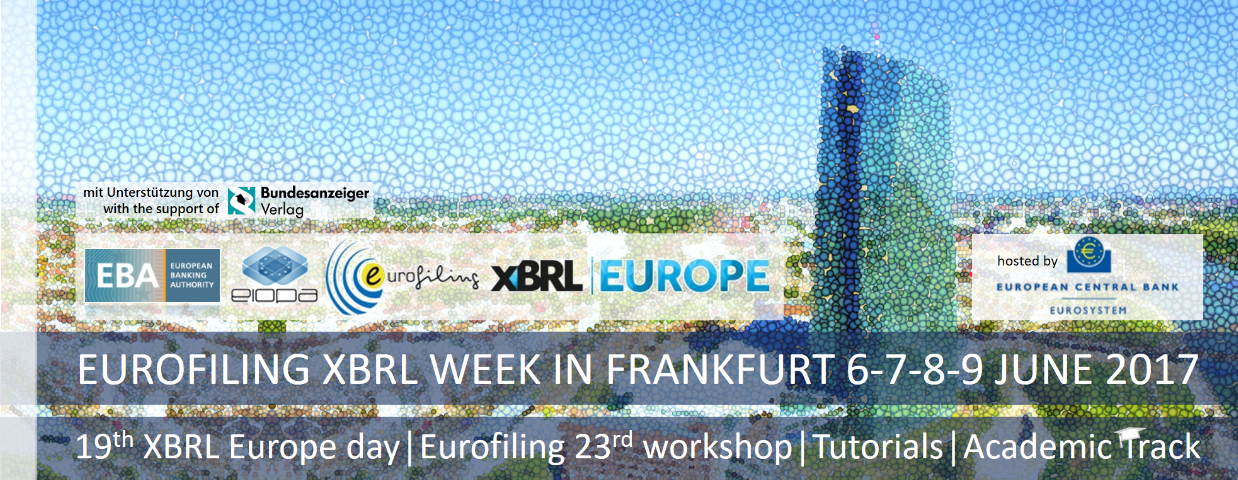
Academic Track – XBRL WEEK 2017, June 7-8, 2017.
European Central Bank, Frankfurt, Germany
Title: "Integration and Exploration of Financial Data using Semantics and Ontologies" ![]()
This projects explores the possibilities of the formalisation of business XML standards implicit semantics. Their formalisation using OWL web ontologies tries to facilitate B2B data integration and the development of business applications.
The formalisation process is based on the XML Semantics Reuse Methodology and its implementation in the ReDeFer tools. First, there is the XSD2OWL mapping, which makes the semantics hidden inside the business standards XML Schemas explicit. This mapping is complemented with the XML2RDF one. The XML to RDF step allows to enrich existing XML data with the semantics previously made explicit by XSD2OWL.
The XML schema reused semantics, now explicit from the computer processing point of view, make more sophisticated computerised processes possible and facilitate data interoperability and business application development.
Some XML-based business standards have been studied and their XML Schemas are being mapped to the corresponding OWL web ontologies. This ontologies are then used to assist during the XML to RDF mapping that generates semantically enriched data from these standards.
Currently, this methodology has been used to generate ontologies for the following initiatives:
The Extensible Business Reporting Language (XBRL) is a language for the electronic communication of business and financial data.
The XML Schemas for XBRL 2.1 have been mapped to OWL ontologies:
A part from the previous schemas, the following schemas have been also mapped in order to be able to map the XBRL Data Submitted in the XBRL Voluntary Program EDGAR promoted by the U.S Securities and Exchange Commission (SEC). These schemas are part of the EDGAR Standard Taxonomies. The US Financial Reporting - February 28, 2005 taxonomies have been considered as they are used by the input data currently submitted to this program. Currently, just some of them have already been mapped:
Sample mappings for EDGAR filings (XML data instantiating and XML Schemas extending the previous XML Schemas):
...+500 EDGAR filings are available from SemanticXBRL as LinkedOpenData.

The Electronic Business using eXtensible Markup Language (ebXML) is an OASIS initiative for electronic business standardisation. The standard is composed of many part but just the following ones have been mapped to OWL ontologies:

The OASIS Web Services Business Process Execution Language (WSBPEL) enables users to describe business process activities as Web services and define how they can be connected to accomplish specific tasks.

|
Academic Track – XBRL WEEK 2017, June 7-8, 2017. |

Carretie, H.; Torvisco, B.; Garcia, R.
International Workshop on Finance and Economics on the Semantic Web, FEOSW'12, 9th Extended Semantic Web Conference, ESWC'12
May 27, 2012, Crete, Greece
CEUR Workshop Proceedings, Vol. 862, pp. 16-30, 2012

García, R.; Gil, R.
In Wood, D. (Ed.) Linking Enterprise Data. pp. 103-125. Springer, 2010
ISBN 978-1-4419-7664-2

García, R.
Position paper, W3C Workshop on Improving Access to Financial Data on the Web, 5-6 October 2009, Arlington, Virginia, USA
Presentation at the workshop ![]()
García, R.; Gil, R.
Linked Data on the Web, LDOW'09. Workshop at the World Wide Web Conference 2009, Madrid, Spain
CEUR Workshop Proceedings, Vol. 538, 2009
ISSN 1613-0073
García, R.; Gil, R.
10th International Conference on Business Information Systems, BIS'07
Lecture Notes in Computer Science, Vol. 4439, pp. 220-232. Springer-Verlag, 2007
ISBN 3-540-72034-0